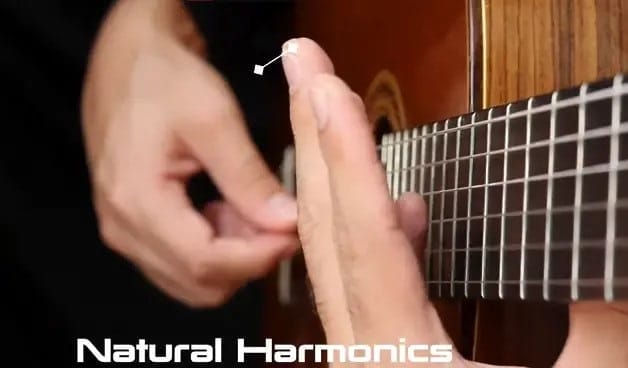Table of Contents
Essential Classical Guitar Techniques for Aspiring Musicians
The classical guitar techniques we know can seem intimidating at first. But as you learn with patience, they will surely enhance your abilities to express more with the guitar.
For those of you who are looking to venture into the world of classical guitar, there are some essential classical guitar techniques that you need to master. If you want to master the instrument and express yourself through it, this is your 101 course.
The guitar itself is configured for specific techniques. Classical guitarists play a variety of pieces composed or arranged for the instrument, often using musical scores to interpret the composer’s intentions.
Check out some must-have classical guitar accessories here.
What is Slur on Classical Guitar?
A slur on classical guitar is a technique where two or more notes are played on the same string without plucking the string with the right hand. This is done by using the left hand to quickly press down on the next fret after the first note has been played. Slurs are also known as hammer-ons and pull-offs.
To play a slur, simply place your left-hand finger on the first fret and pluck the nylon string with your right hand. Then, quickly press down on the next fret with the same finger without plucking the string again. The second note will sound automatic.

You can also play slurs with multiple fingers. For example, you could place your first finger on the first fret and your second finger on the third fret. Then, pluck the string with your right hand and quickly press down on the third fret with your second finger. The second note will sound automatically, and you will be able to play the third note by plucking the string again.
Left-Hand Techniques
Classical guitarists use a variety of left-hand techniques to produce different musical effects and to execute complex passages. Here are some common left-hand techniques in classic guitar playing
Legato
Legato is a technique that allows you to play notes smoothly and seamlessly on the classical guitar. Instead of picking the strings with the right hand, it involves using the left-hand fingers to hammer on or pull off the strings. This way, you can create a fluid and expressive sound that mimics the human voice.
To practice legato, you need to develop strength and accuracy in your left-hand fingers. Start with simple exercises that involve two or three notes per string. For example, you can play the first four frets on each string, alternating between hammer-ons and pull-offs. Make sure you press the string firmly and release it quickly without lifting your finger too high.

Use a metronome to keep a steady tempo and rhythm. Start slowly and gradually increase the speed as you gain confidence and control. Try to play each note evenly and clearly, without any gaps or noises.
Apply legato to scales, arpeggios, and melodies that you already know. Experiment with different combinations of hammer-ons and pull-offs, and see how they affect the sound and mood of the music. For example, you can use legato to create smooth transitions between notes or to add some flair and expression to a phrase.
Listen to classical guitarists who use legato effectively, such as Andrés Segovia, Julian Bream, or John Williams. Observe how they use this classical technique to enhance their musical expression and style. Try to emulate their sound and feel in your own playing.
Check out our blog about legato guitar techniques.
Vibrato
Vibrato is a very expressive technique, not exclusive to the classical guitar. It is a subtle variation of pitch that adds warmth and emotion to the sound. The vibrato can be performed in different ways, depending on the finger position and the desired effect.
How To Perform Horizontal Vibrato?
The most common type of vibrato is the horizontal vibrato, where the finger moves back and forth along the string, slightly changing the tension and pitch. This type of vibrato is suitable for notes played on the first three frets, where there is more space to move.

To perform a horizontal vibrato, place your finger firmly on the string and gently rock it towards the nut and back to the original position. The movement should be smooth and even, not jerky or erratic. The speed and width of the vibrato can vary depending on the mood and style of the classical guitar music.
How to perform vertical vibrato?
To perform a vertical vibrato, place your finger lightly on the string, gently push it down, and release it back to its original position. The movement should be small and fast, not large or slow. The intensity and frequency of the vibrato can vary depending on the expression and character of the music.
The vibrato technique can enhance any musical piece by adding color and expression to the sound. It can also help to mask any intonation problems or imperfections in tone.
However, it should not be overused or abused, as it can become distracting or annoying. The vibrato should be applied tastefully and appropriately, according to the context and mood of the music.
Learn more about the vibrato technique from our blog.
Right-Hand Techniques
In classical guitar, there are various ways where you can use the right hand techniques to produce a good tone and sound on the instrument. These techniques include:
Fingerpicking
One of the most beautiful and expressive ways to play the classical guitar is by using the fingerpicking technique – also the most vital of classical guitar techniques.
This technique involves plucking the strings with the fingertips or nails of the right hand instead of using a pick. Fingerpicking allows you to create rich and varied sounds, as well as to play multiple notes at the same time. To master the fingerpicking technique, you need to practice some basic skills.

First, learn to position your right hand correctly over the strings, with your thumb resting on the sixth string and your index, middle, and ring fingers on the third, second, and first strings, respectively.
You should develop independence and coordination between your fingers so that you can pluck different strings and rhythms at different times. Also, learn how to use different patterns of fingerpicking, such as alternating bass, arpeggios, rolls, and Travis picking.
It helps to apply fingerpicking to different genres and styles of music, such as classical, folk, blues, and pop. Rearranging songs you like for fingerpicking can also be very enjoyable and educational.
Tremolo
One of the most beautiful and challenging techniques in classical guitar is the tremolo. Tremolo is a technique where you play a single note repeatedly with different fingers of your right hand, creating the illusion of a sustained sound. Tremolo can be used to create a melody over a bass line or to add texture and expression to a piece.
To play tremolo, you need to have good control of your right-hand fingers and a relaxed wrist. The most common tremolo pattern is p-a-m-i, where p plays the bass note, and a-m-i plays the same treble note in succession. You can also use other patterns, such as p-i-a-m or p-m-a-i, depending on the musical context and your preference. Here, P stands for the thumb, I for the index finger, M for the middle finger, and A for the ring finger.

The key to playing tremolo well is to keep the rhythm even and consistent. You should practice with a metronome and start slowly, gradually increasing the speed as you gain confidence and accuracy.
You should also pay attention to the tone and volume of each finger, making sure they are balanced and clear. You can vary the dynamics and articulation of the tremolo to create different effects and emotions.
Tremolo is a technique that requires patience and perseverance to master, but it can also be very rewarding and enjoyable. Some of the most famous pieces that use tremolo are:
- Recuerdos de la Alhambra by Francisco Tárrega,
- Una Limosna por el Amor de Dios by Agustín Barrios,
- Asturias by Isaac Albéniz.
You can read our blog about tremolo guitar technique.
Left & Right Hand Techniques
The two hands of classical guitar are equally important, and both hands require a variety of techniques to play the instrument well.
The right hand plucks the strings, and the left hand frets the strings. But to produce a clear, accurate, and expressive sound, it is important to coordinate both of your hands.
Here are some of the most important techniques for both hands in classical guitar.
Arpeggios
Not many people in the field of technical practice adore arpeggios. But it is one of the most beautiful techniques for playing the classical guitar is arpeggiating. This means plucking the strings one by one in a pattern while holding a chord shape, instead of strumming them all together. Arpeggiating creates a smooth and melodic sound that can enhance any piece of music.
To master this technique, you need to practice your right-hand finger finger dexterity and coordination, as well as your left-hand fretting and shifting.
Start with simple patterns that use only two or three strings, such as P-I-M or P-A-M-I. You can use any combination of these fingers to create different patterns. Try to keep your fingers close to the strings and avoid unnecessary movements.
Gradually increase the complexity and speed of your patterns, adding more strings and variations. You can also try different rhythms and accents to create more interest and expression. For example, you can play a triplet pattern (three notes per beat) or a syncopated pattern (accenting the off-beats).

It’s very important to practice arpeggiating with as many chords and scales as you can learn, both in open and closed positions. This will help you develop your left-hand technique and expand your musical vocabulary. You can also practice arpeggiating over a backing track or a metronome to improve your timing and groove.
Listen to some examples of classical guitarists who use arpeggiating in their playing, such as Andrés Segovia, Julian Bream, or John Williams. Pay attention to how they use this technique to create different moods and textures in their music. Try to emulate their style and learn from their choices.
Check out our arpeggio guitar techniques blog, to learn more.
Harmonics
Harmonics serve as a way to add some sparkle and variety to your classical guitar playing. They are produced by lightly touching the string at certain points along its length instead of pressing it down to the fretboard and plucking the string. This creates a high-pitched sound that is an octave or more above the normal note.
Players can play Harmonics on any string, but they are most commonly found at the 12th, 7th, and 5th frets. These are called natural harmonics because they divide the string into equal parts.
There are also artificial harmonics, which are created by using your right hand to touch the string at a certain distance from the note you are fretting with your left hand. This allows you to play harmonics anywhere on the fretboard and even create melodies with them.

Harmonics can be used to create contrast, highlight a phrase, or add some color to your music. They can also be combined with normal notes to create a rich and complex sound.
Check out our guitar harmonics blog to learn more about it.
FAQs Classical Guitar Techniques
Do classical guitarists use their thumbs?
Yes, classical guitarists use their thumbs. The left thumb is used to support the neck of the guitar and to fret notes on the lower strings. The right thumb is used to pluck the strings.
What is the finger technique for classical guitar?
The finger technique for classical guitar involves precise and controlled use of the fingers to pluck the strings. Here’s a basic overview:
- Posture and Position: Proper hand positioning is critical. The wrist should be relatively straight, and the fingers need to be arched.
- Plucking the Strings: Fingers are used to pluck the strings from above and not by pulling them sideways. The motion is generally inwards towards the palm.
- Alternation: For smoother and faster playing, fingers are often alternated, especially ‘i’ and ‘m’.
- Precision and Control: Emphasis is on control, clarity, and expression rather than speed or force.
What is the hardest guitar technique?
Identifying the “hardest” guitar technique can be subjective, as it often depends on the individual player’s strengths, weaknesses, and style. However, some commonly acknowledged challenging techniques include:
- Sweep Picking: This involves ‘sweeping’ the pick across several strings in a single fluid motion while coordinating with the fretting hand to play arpeggios rapidly.
- Finger Tapping: This technique, often associated with electric guitar, involves tapping the strings on the fretboard with the fingers of the picking hand, creating a fast and fluid sound.
- Classical Tremolo: A demanding technique where a single note is rapidly repeated using three fingers (‘a’, ‘m’, ‘i’) while maintaining melody and bass lines, creating a continuous, flowing sound.
- String Skipping: This involves playing non-adjacent strings alternately, requiring precise hand coordination and pick control.
- Advanced Bending and Vibrato: While common in electric guitar playing, mastering these with control, accuracy, and musicality can be challenging.
Each of these techniques can present significant challenges, and mastering them requires dedicated practice and a deep understanding of the instrument.
The Techniques Define It All
A musician’s style is defined by the techniques they favor and incorporate into their playing. Learning new techniques helps evolve one’s style and expand boundaries. Aside from the basic techniques mentioned above, there exists a multitude of more advanced (and more fun) classical guitar techniques – all for you to dive into. Never stop learning!
FAQs of Classical Guitar Techniques
Yes, classical guitarists use their thumbs. The left thumb is used to support the neck of the guitar and to fret notes on the lower strings. The right thumb is used to pluck the strings.
The finger technique for classical guitar involves precise and controlled use of the fingers to pluck the strings. Here’s a basic overview:
Posture and Position: Proper hand positioning is critical. The wrist should be relatively straight, and the fingers need to be arched.
Plucking the Strings: Fingers are used to pluck the strings from above and not by pulling them sideways. The motion is generally inwards towards the palm.
Alternation: For smoother and faster playing, fingers are often alternated, especially ‘i’ and ‘m’.
Precision and Control: Emphasis is on control, clarity, and expression rather than speed or force.
Intermediate classical guitar techniques focus on refining right hand skills like arpeggios, slurs, and barre chords, as well as left hand techniques like scales and stretches. You might also explore flamenco’s rasgueado and add expression with vibrato. Even expert guitarists have difficulty with trills and other expansions of the left-hand guitar method. Practice consistently with a focus on accuracy and proper form!
Identifying the “hardest” guitar technique can be subjective, as it often depends on the individual player’s strengths, weaknesses, and style. However, some commonly acknowledged challenging techniques include:
Sweep Picking: This involves ‘sweeping’ the pick across several strings in a single fluid motion while coordinating with the fretting hand to play arpeggios rapidly.
Finger Tapping: This technique, often associated with electric guitar, involves tapping the strings on the fretboard with the fingers of the picking hand, creating a fast and fluid sound.
Classical Tremolo: A demanding technique where a single note is rapidly repeated using three fingers (‘a’, ‘m’, ‘i’) while maintaining melody and bass lines, creating a continuous, flowing sound.
String Skipping: This involves playing non-adjacent strings alternately, requiring precise hand coordination and pick control.
Advanced Bending and Vibrato: While common in electric guitar playing, mastering these with control, accuracy, and musicality can be challenging.
Each of these techniques can present significant challenges, and mastering them requires dedicated practice and a deep understanding of the instrument.
- 6 Unique Guitar Picks That Will Blow Your Mind - April 18, 2024
- 9 Most Unique Guitar Designs that will Blow Your Mind - April 18, 2024
- Unusual and Unique Guitar Accessories of 2024 - April 18, 2024









